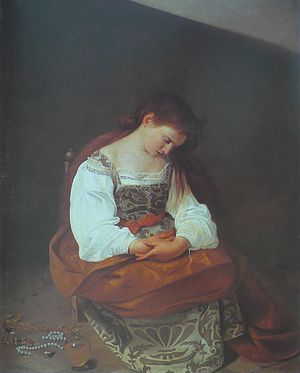art.wikisort.org - Gemälde
Die Reuige Magdalena (Originaltitel Maddalena penitente) ist ein gemaltes Portraitbildnis von Caravaggio, das die reuige Maria Magdalena (Maria aus Magdala) abbildet. Es entstand um 1597 (andere Quellen geben 1594–1595 an) und wurde mit Ölfarben auf Leinwand gemalt.
 |
| Maddalena penitente − Reuige Magdalena − |
|---|
| Michelangelo Merisi da Caravaggio, ca. 1597 |
| Öl auf Leinwand |
| 122,5 × 98,5 cm |
| Galleria Doria Pamphilj, Rom |
Das Gemälde befindet sich heute im Palazzo Pamphilj in Rom (Galleria Doria Pamphilj).
Szene/Motiv
Die hl. Maria Magdalena Büßerin befindet sich in ihrem Versteck und sitzt zusammengesackt mit verschränkten Armen auf einem Stuhl. Sie wird am Tiefpunkt ihres Lasterlebens dargestellt, das ihr hier bewusst wird. Daneben liegen ihre Habseligkeiten auf dem Boden.[1]
Die Frau, die für Caravaggio hier Modell stand, ist dieselbe wie auf seinem Gemälde Ruhe auf der Flucht nach Ägypten (um 1597).
Maria Magdalena wurde von Caravaggio nochmals in einem späteren Gemälde in Ekstase dargestellt.
Weblinks
- Stephen Moss: M by Peter Robb. In: The Guardian. 9. Februar 2000, abgerufen am 14. Dezember 2014.
Literatur
- Mary D. Garrard: Artemisia Gentileschi around 1622: the shaping and reshaping of an artistic identity. University of California Press, 2001, ISBN 978-0-520-22841-2.
- Giulio Mancini (ca. 1617–1621) Considerazioni sulla pittura. Zitiert in Howard Hibbard: Caravaggio. Westview Press, 1985, ISBN 978-0-06-430128-2, S. 346 et seq.
- Kimberley Christine Patton, John Stratton Hawley: Holy tears: weeping in the religious imagination. Princeton University Press, 2005, ISBN 978-0-691-11444-6 (Google Books [abgerufen am 24. Dezember 2014]).
- Peter Robb: M: The Man Who Became Caravaggio. Macmillan, 2001, ISBN 978-0-312-27474-0.
- Ingrid Drake Rowland: From heaven to Arcadia: the sacred and the profane in the Renaissance. New York Review of Books, 2005, ISBN 978-1-59017-123-3.
- Hilary Spurling: The New York Times Book Reviews 2000. Taylor & Francis, 2001, ISBN 978-1-57958-058-2, The Other Michelangelo, S. 396 et seq (Google Books [abgerufen am 14. Dezember 2014]).
- Carol Strickland, John Boswell: The annotated Mona Lisa: a crash course in art history from prehistoric to post-modern. Andrews McMeel Publishing, 1992, ISBN 978-0-8362-8005-0 (Google Books [abgerufen am 14. Dezember 2014]).
- John L. Varriano: Caravaggio: the Art of Realism. Penn State Press, 2006, ISBN 978-0-271-02717-3 (Google Books [abgerufen am 14. Dezember 2014]).
- Genevieve Warwick: Caravaggio: Realism, Rebellion, Reception. University of Delaware Press, 2006, ISBN 978-0-87413-936-5 (Google Books [abgerufen am 14. Dezember 2014]).
Einzelnachweise
- Patton and Hawley (2005), p. 219.
На других языках
- [de] Reuige Magdalena (Caravaggio)
[en] Penitent Magdalene (Caravaggio)
Penitent Magdalene (also called Repentant Madalene) is a 16th-century oil on canvas painting by Italian Baroque painter Caravaggio. The painting portrays a repentant Mary Magdalene, bowed over in penitent sorrow as she leaves behind her dissolute life, its trappings abandoned beside her.[1] At the time of its completion, ca. 1594–1595, the painting was unconventional for its contemporary realism and departure from traditional Magdalene iconography.[2][3] It has invited both criticism and praise, with speculation even into the 21st century as to Caravaggio's intentions. The work hangs in the Doria Pamphilj Gallery in Rome.[4][es] Magdalena penitente (Caravaggio)
Magdalena penitente (o Magdalena llorosa) es un cuadro del pintor italiano Caravaggio, realizado en 1596. Fue parte de un conjunto destinado a decorar las habitaciones de su primer mecenas, el cardenal Francesco Maria Del Monte. La modelo fue una prostituta que a la postre participaría en La muerte de la Virgen, y que años más tarde fue encontrada muerta en el Tíber. Este cuadro habla especialmente de la escasez de recursos de Caravaggio, pues el vestido de la modelo fue usado por el pintor en Narciso, y solía recurrir siempre a las mismas modelos. Sin embargo, el cuadro demuestra el arrepentimiento de la otrora cortesana y su melancolía por ser pecadora. Es una imagen de un alma desnuda. Es algo difícil de expresar con palabras.[fr] Madeleine repentante (Le Caravage)
La Madeleine repentante est un tableau exécuté par Caravage, vers 1593-1594, soit peu après son installation à Rome.[it] Maddalena penitente (Caravaggio)
La Maddalena penitente è un dipinto eseguito da Caravaggio attorno al 1594-1595 e conservato nella Galleria Doria Pamphilj di Roma.[ru] Кающаяся Магдалина (картина Караваджо)
Кающаяся Магдалина (также называемая Кающейся Мадаленой ) — картина итальянского мастера барокко Микеланджело Меризи да Караваджо. На картине изображена раскаявшаяся Мария Магдалина, преклонившаяся в раскаянии, когда она оставляет позади свою распутную жизнь, рядом с ней изображены ее традиционные атрибуты[1]. На момент написания (около 1594–1595) картина отличалась нетрадиционным современным реализмом и отходом от традиционного изображения Магдалины[2][3]. Работа находится в галерее Дориа-Памфили в Риме[4].Другой контент может иметь иную лицензию. Перед использованием материалов сайта WikiSort.org внимательно изучите правила лицензирования конкретных элементов наполнения сайта.
WikiSort.org - проект по пересортировке и дополнению контента Википедии